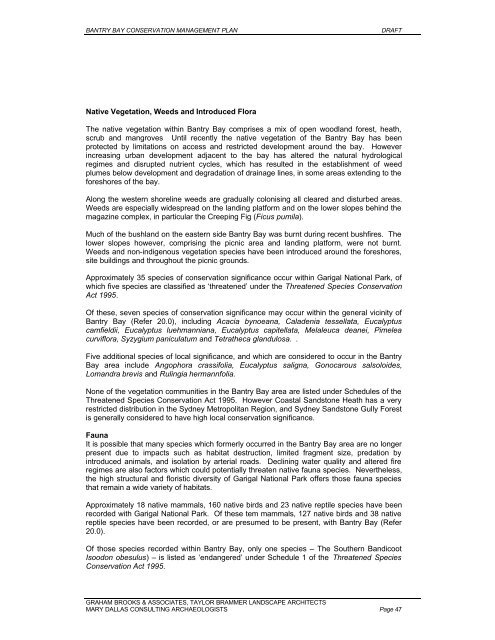Bantry Bay (Garigal National Park) - Department of Environment and ...
Bantry Bay (Garigal National Park) - Department of Environment and ...
Bantry Bay (Garigal National Park) - Department of Environment and ...
You also want an ePaper? Increase the reach of your titles
YUMPU automatically turns print PDFs into web optimized ePapers that Google loves.
BANTRY BAY CONSERVATION MANAGEMENT PLAN<br />
DRAFT<br />
Native Vegetation, Weeds <strong>and</strong> Introduced Flora<br />
The native vegetation within <strong>Bantry</strong> <strong>Bay</strong> comprises a mix <strong>of</strong> open woodl<strong>and</strong> forest, heath,<br />
scrub <strong>and</strong> mangroves Until recently the native vegetation <strong>of</strong> the <strong>Bantry</strong> <strong>Bay</strong> has been<br />
protected by limitations on access <strong>and</strong> restricted development around the bay. However<br />
increasing urban development adjacent to the bay has altered the natural hydrological<br />
regimes <strong>and</strong> disrupted nutrient cycles, which has resulted in the establishment <strong>of</strong> weed<br />
plumes below development <strong>and</strong> degradation <strong>of</strong> drainage lines, in some areas extending to the<br />
foreshores <strong>of</strong> the bay.<br />
Along the western shoreline weeds are gradually colonising all cleared <strong>and</strong> disturbed areas.<br />
Weeds are especially widespread on the l<strong>and</strong>ing platform <strong>and</strong> on the lower slopes behind the<br />
magazine complex, in particular the Creeping Fig (Ficus pumila).<br />
Much <strong>of</strong> the bushl<strong>and</strong> on the eastern side <strong>Bantry</strong> <strong>Bay</strong> was burnt during recent bushfires. The<br />
lower slopes however, comprising the picnic area <strong>and</strong> l<strong>and</strong>ing platform, were not burnt.<br />
Weeds <strong>and</strong> non-indigenous vegetation species have been introduced around the foreshores,<br />
site buildings <strong>and</strong> throughout the picnic grounds.<br />
Approximately 35 species <strong>of</strong> conservation significance occur within <strong>Garigal</strong> <strong>National</strong> <strong>Park</strong>, <strong>of</strong><br />
which five species are classified as ‘threatened’ under the Threatened Species Conservation<br />
Act 1995.<br />
Of these, seven species <strong>of</strong> conservation significance may occur within the general vicinity <strong>of</strong><br />
<strong>Bantry</strong> <strong>Bay</strong> (Refer 20.0), including Acacia bynoeana, Caladenia tessellata, Eucalyptus<br />
camfieldii, Eucalyptus luehmanniana, Eucalyptus capitellata, Melaleuca deanei, Pimelea<br />
curviflora, Syzygium paniculatum <strong>and</strong> Tetratheca gl<strong>and</strong>ulosa. .<br />
Five additional species <strong>of</strong> local significance, <strong>and</strong> which are considered to occur in the <strong>Bantry</strong><br />
<strong>Bay</strong> area include Angophora crassifolia, Eucalyptus saligna, Gonocarous salsoloides,<br />
Lom<strong>and</strong>ra brevis <strong>and</strong> Rulingia hermannfolia.<br />
None <strong>of</strong> the vegetation communities in the <strong>Bantry</strong> <strong>Bay</strong> area are listed under Schedules <strong>of</strong> the<br />
Threatened Species Conservation Act 1995. However Coastal S<strong>and</strong>stone Heath has a very<br />
restricted distribution in the Sydney Metropolitan Region, <strong>and</strong> Sydney S<strong>and</strong>stone Gully Forest<br />
is generally considered to have high local conservation significance.<br />
Fauna<br />
It is possible that many species which formerly occurred in the <strong>Bantry</strong> <strong>Bay</strong> area are no longer<br />
present due to impacts such as habitat destruction, limited fragment size, predation by<br />
introduced animals, <strong>and</strong> isolation by arterial roads. Declining water quality <strong>and</strong> altered fire<br />
regimes are also factors which could potentially threaten native fauna species. Nevertheless,<br />
the high structural <strong>and</strong> floristic diversity <strong>of</strong> <strong>Garigal</strong> <strong>National</strong> <strong>Park</strong> <strong>of</strong>fers those fauna species<br />
that remain a wide variety <strong>of</strong> habitats.<br />
Approximately 18 native mammals, 160 native birds <strong>and</strong> 23 native reptile species have been<br />
recorded with <strong>Garigal</strong> <strong>National</strong> <strong>Park</strong>. Of these tem mammals, 127 native birds <strong>and</strong> 38 native<br />
reptile species have been recorded, or are presumed to be present, with <strong>Bantry</strong> <strong>Bay</strong> (Refer<br />
20.0).<br />
Of those species recorded within <strong>Bantry</strong> <strong>Bay</strong>, only one species – The Southern B<strong>and</strong>icoot<br />
Isoodon obesulus) – is listed as ‘endangered’ under Schedule 1 <strong>of</strong> the Threatened Species<br />
Conservation Act 1995.<br />
GRAHAM BROOKS & ASSOCIATES, TAYLOR BRAMMER LANDSCAPE ARCHITECTS<br />
MARY DALLAS CONSULTING ARCHAEOLOGISTS Page 47
















